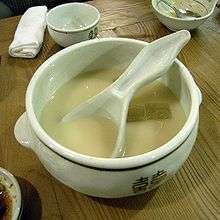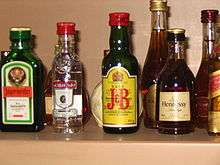Makgeolli
| Makgeolli | |
 A bowl of makgeolli. | |
| Korean name | |
|---|---|
| Hangul | 막걸리 |
| Revised Romanization | Makgeolli |
| McCune–Reischauer | Makkŏlli |
Makgeolli (Hangul: 막걸리 ), also known as "makkoli", "makoli", "makguli", "makgoli", "makeolli" or "makuly (takju)", is a slightly sweet alcoholic beverage native to Korea. It is made from rice or wheat mixed with nuruk, a Korean fermentation starter.[1] It has a milky, off-white color and is about 6–8% alcohol by volume. Makgeolli is traditionally made from rice, although variations are made from wheat, and some brands are flavored with corn, chestnut, apple or other produce.
The name makgeolli has its origin in the Korean language, in which it is a compound that consists of a prefix mak- ("roughly, coarsely, recklessly, carelessly") and a deverbal noun derived from the verb georeu- ~ geoll- ("to strain, to sift, to filter"). It was originally quite popular among farmers, earning it the name nongju (농주 / 農酒), which means farmer liquor. However, it has recently become more popular in cities, especially with the younger generations. Dongdongju (동동주) is a drink very similar to makgeolli, and both are commonly imbibed alongside Korean pancakes such as pajeon (파전) or bindaetteok (빈대떡).
History
According to The Poetic Records of Emperors and Kings (Jewangun-gi), written during the Goryeo Dynasty, the first mention of the drink was in the founding story of the Goguryeo during the reign of King Dongmyeong. Many communities in Korea around that time enjoyed the tradition of drinking and dancing all night in special ceremonies. During the Goryeo dynasty, makgeolli was called ihwa-ju (pear blossom alcohol), as the liquor was made during the blossoming of that particular flower.[2]
Use
Commercially, makgeolli is most commonly available in plastic bottles or aseptic box containers. Traditionally, it is served in a large metal or wooden bowl from which individual cups and bowls are filled using a ladle. Korean jars also are a traditional vessel for makgeolli consumption. As it is an unfiltered beverage, makgeolli is generally shaken or stirred before being consumed, as the cloudy white portion tends to settle to the bottom, leaving a pale yellow-clear liquid on top.
Cheong-Ju (makgeolli without the white portion) is used during ancestral rites in Korea.
Availability and manufacture
In 2011, Korean importers in Japan started producing makgeolli products, attempting to promote them under the name makkori (マッコリ), the Japanese pronunciation of makgeolli.[3] It has been suggested that this may lead people to mistakenly regard makgeolli as being traditionally Japanese rather than Korean.[4]
To fit consumer tastes, research into standardization to reduce off-flavors and ensure consistency between batches has been applied in modern production. Flavorings such as fruit and ginseng are also sometimes added, along with aspartame, which gives sweetness without adding a fermentable carbohydrate, increasing shelf life and flavor stability in commercial brands. As the result of these efforts, sales have increased.[5] The Ministry for Food, Agriculture, Forestry, and Fisheries announced plans for enhancing the competitiveness of alcoholic beverages on August 26, 2009, which includes plans for the makgeolli industry.[6]

English naming
The winner of a public contest by the Korean Ministry for Food, Agriculture, Forestry, and Fisheries for the selection of an English name for makgeolli was "drunken rice", with the Ministry reasoning that foreigners would understand it is a type of liquor made from rice. "Mackohol" and "markelixir" were the runners-up.[7] Nevertheless, an 11-country survey identified Korea rice wine as the term that most easily conveys the idea of makgeolli.[8]
See also
- Cheongju
- Sake
- Nigori
- Choujiu
- Gamju
- Korean alcoholic beverages
- Korean culture
- Korean cuisine
- List of rice beverages
-
.svg.png) Drink portal
Drink portal
References
- ↑ http://www.harmsboone.org/homebrewers-guide-makgeolli
- ↑ KOREA.NET (2009-06-22). "Korean-style food: History of makgeolli, a traditional alcoholic beverage". Koreanfood-koreanet.blogspot.com. Retrieved 2011-01-24.
- ↑ JoongAng Ilbo (2009-11-05). "'「日本で"抱川マッコリ"登録した人は韓国人」". Retrieved 2012-11-17.
- ↑ 이진우(Jinu Lee) (2011-04-01). "'막걸리' 명칭 일본에 빼앗길 판". asiatoday.co.kr. Retrieved 2011-04-02.
- ↑ Noh, Seung-Hyuk (2010-09-08). "충주 예성여고생들 오곡 막걸리로 특허". Yonhap News. Retrieved 2010-09-13.
- ↑ http://www.mifaff.go.kr/gonews/content_view.jsp?newsid=155367438§ion_id=b_sec_1
- ↑ "막걸리 영문애칭 "Drunken Rice," "Makcohol," "Markelixir" 뽑혀". KOREA.KR.
- ↑ "막걸리 영문애칭 '드렁큰라이스(Drunken Rice)". ajnews.co.kr.


